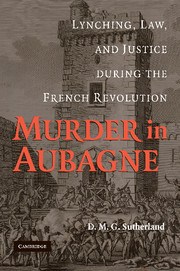Book contents
- Frontmatter
- Contents
- List of Figures
- Preface
- Acknowledgments
- Abbreviations
- Aubagne: An Introduction to the Problem
- 1 Structures and Events
- 2 The Olive Festival
- 3 Aubagne's Universe: Marseille, Aix, and Arles, 1789–1792
- 4 Murders in Provence
- 5 Vigilantism and Federalism
- 6 Federalism
- 7 Terror in a Small Town: Aubagne
- 8 The Revolution of the Antiterrorists: Vengeance, Massacre, and Justice
- 9 The Bande d'Aubagne
- Conclusion
- Appendix
- Sources and Methods
- Index
7 - Terror in a Small Town: Aubagne
Published online by Cambridge University Press: 13 August 2009
- Frontmatter
- Contents
- List of Figures
- Preface
- Acknowledgments
- Abbreviations
- Aubagne: An Introduction to the Problem
- 1 Structures and Events
- 2 The Olive Festival
- 3 Aubagne's Universe: Marseille, Aix, and Arles, 1789–1792
- 4 Murders in Provence
- 5 Vigilantism and Federalism
- 6 Federalism
- 7 Terror in a Small Town: Aubagne
- 8 The Revolution of the Antiterrorists: Vengeance, Massacre, and Justice
- 9 The Bande d'Aubagne
- Conclusion
- Appendix
- Sources and Methods
- Index
Summary
After the defeat of Federalism in Marseille and its evaporation in Aubagne, authorities faced the problem of how to organize repression. By September 1793, the law had criminalized a great deal of political activity: armed insurrection or attendance at a counterrevolutionary assembly (Law of 19 March 1793), being an official of a Federalist institution, taking the oath not to recognize the laws of the Convention passed after 31 May, being a witness before an illegal tribunal, denouncing patriots, signing passports, and so on (Law of 5 July 1793). The Law of 19 June applied to officials of major Federalist civilian institutions. Thus for Marseille, all officials of the Popular Tribunal of Marseille, the General Committee of the Thirty-Two Sections, officers of the Sections, and the Trois Corps were liable. For Aubagne, former members of the Sectional Committees, the comité de surveillance, and the municipality were targets for punishment.
Justice in the Terror
Revolutionary justice was supposed to be shocking and rapid. Its main features were the denial of an appeal and the requirement that executions occur twenty-four hours after the verdict. Revolutionary jurisprudence also eliminated most procedural protections for the accused. The institution of a jury d'accusation, or grand jury, in which the state had to present the preliminaries of its case, did not apply. Revolutionary justice also eliminated the long process of gathering information about a particular crime that was so common in the Old Regime or in the early years of the Revolution.
- Type
- Chapter
- Information
- Murder in AubagneLynching, Law, and Justice during the French Revolution, pp. 170 - 213Publisher: Cambridge University PressPrint publication year: 2009

